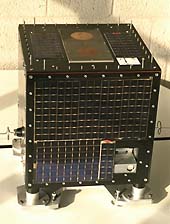TUBSAT-A
| TUBSAT-A | |
|---|---|

|
|
| Type: | Microsatellite |
| Country: |
|
| Operator: | ILR ( TU Berlin ) |
| COSPAR-ID : | 1991-050D |
| Mission dates | |
| Dimensions: | 35 kg |
| Size: | 38 × 38 × 38 cm |
| Begin: | June 17, 1991, 01:46 UTC |
| Starting place: | Kourou ELA-2 |
| Launcher: | Ariane 40 V80 |
| Status: | Project finished |
| Orbit data | |
| Rotation time : | 100.2 min |
| Orbit inclination : | 98.5 ° |
| Apogee height : | 772 km |
| Perigee height : | 762 km |
TUBSAT-A was the first microsatellite of the Institute for Aerospace ( ILR ) of the TU Berlin . The ILR took over the development and construction of the satellite with project management by Udo Renner, the funding was guaranteed by the Federal Ministry of Education and Research . The satellite served as a communications satellite and technology test vehicle. It was launched on June 17, 1991 with an Ariane 4 into a 780 km sun-synchronous orbit. In 2005 it was still in operation, but was no longer actively used.
purpose
The satellite was mainly used for communication with the smallest ground stations, which were built into GPS collars of deer and storks and in floating sea buoys or used as a communication system by Arctic expeditions. For this purpose, a digital voice memory developed at the Institute for Telecommunication Technology at the TU Berlin is on board, which can store short incoming messages and play them back and send them out at a different time. H. when the satellite is over another location. (The Iridium system and similar global communication systems were not yet operational when the mission started.)
Technical specifications
- 38 × 38 × 38 cm cube
- 35 kg mass
- VHF communication system
See also
Web links
- TUBSAT-A Overview (English)
Individual evidence
- ↑ Completed projects of the ILR
- ↑ TUBSAT in the Encyclopedia Astronautica , accessed August 3, 2012 (English).